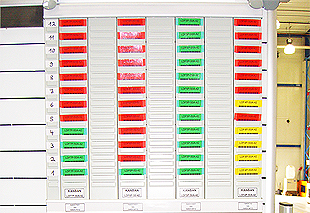Kanban
What is Kanban?
Kanban (literally signboard or billboard in Japanese) is a scheduling system for lean and just-in-time (JIT) production. Kanban is a system to control the logistical chain from a production point of view, and is not an inventory control system. Kanban was developed by Taiichi Ohno, at Toyota, as a system to improve and maintain a high level of production. Kanban is one method through which JIT is achieved.
Kanban became an effective tool in support of running a production system as a whole and it proved to be an excellent way for promoting improvement. Problem areas were highlighted by reducing the number of kanban in circulation. One of the main benefits of Kanban is to establish an upper limit to the work in progress inventory, avoiding overloading of the manufacturing system. Other systems with similar effect are for example CONWIP. A systematic study of various configurations of Kanban systems, of which CONWIP is an important special case, can be found in Tayur (1993), among other papers.
Origins
In the late 1940s, Toyota started studying supermarkets with the idea of applying shelf-stocking techniques to the factory floor. In a supermarket, customers obtain the required quantity of product at the required time; no more and no less. Furthermore, the supermarket stocks only what it expects to sell within a given time frame, and customers take only what they need, since future supply is assured. This observation led Toyota to view a process as being a customer of one or more preceding processes, and the preceding processes are viewed as a kind of store. The “customer” process goes to the store to obtain required components which in turn causes the store to restock. Originally, as in supermarkets, signboards were used to guide “shopping” processes to specific shopping locations within the store.
Kanban aligns inventory levels with actual consumption; a signal is sent to produce and/or deliver a new shipment when material is consumed. These signals are tracked through the replenishment cycle, bringing visibility to the supplier, the consumer and the buyer.
Kanban uses the rate of demand to control the rate of production, passing demand from the end customer up through the chain of customer-store processes. In 1953, Toyota applied this logic in their main plant machine shop.
Operation
One key indicator of the success of production scheduling based on demand “pushing” is the ability of the demand-forecast to create such a “push”. Kanban, by contrast, is part of an approach where the “pull” comes from demand. Re-supply or production is determined according to the actual demand of the customer. In contexts where supply time is lengthy and demand is difficult to forecast, often, the best one can do is to respond quickly to observed demand. This situation is exactly what a kanban system accomplishes, in that it is used as a demand signal that immediately travels through the supply chain. This ensures that intermediate stock held in the supply chain are better managed, and are usually smaller. Where the supply response is not quick enough to meet actual demand fluctuations, thereby causing potential lost sales, stock building may be deemed more appropriate, and is achieved by placing more kanban in the system.
Taiichi Ohno stated that to be effective, kanban must follow strict rules of use. Toyota, for example, has six simple rules, and close monitoring of these rules is a never-ending task, thereby ensuring that the kanban does what is required.
Toyota’s Six Rules
- Later process picks up the number of items indicated by the kanban at the earlier process.
- Earlier process produces items in the quantity and sequence indicated by the kanban.
- No items are made or transported without a kanban.
- Always attach a kanban to the goods.
- Defective products are not sent on to the subsequent process. The result is 100% defect-free goods.
- Reducing the number of kanban increases the sensitivity.
Kanban cards
 Kanban cards are a key component of kanban and they signal the need to move materials within a production facility or to move materials from an outside supplier in to the production facility. The kanban card is, in effect, a message that signals depletion of product, parts or inventory that, when received, the kanban will trigger the replenishment of that product, part or inventory. Consumption therefore drives demand for more production, and demand for more product is signaled by the kanban card. Kanban cards therefore help create a demand-driven system.
Kanban cards are a key component of kanban and they signal the need to move materials within a production facility or to move materials from an outside supplier in to the production facility. The kanban card is, in effect, a message that signals depletion of product, parts or inventory that, when received, the kanban will trigger the replenishment of that product, part or inventory. Consumption therefore drives demand for more production, and demand for more product is signaled by the kanban card. Kanban cards therefore help create a demand-driven system.
It is widely held by proponents of lean production and manufacturing that demand-driven systems lead to faster turnarounds in production and lower inventory levels, helping companies implementing such systems to be more competitive.
In the last few years, systems sending kanban signals electronically have become more widespread. While this trend is leading to a reduction in the use of kanban cards in aggregate, it is still common in modern lean production facilities to find use of kanban cards. In Oracle ERP (enterprise resource planning) software, kanban is used for signalling demand to suppliers through email notifications. When stock of a particular component is depleted by the quantity assigned on kanban card, a “kanban trigger” is created (which may be manual or automatic), a purchase order is released with predefined quantity for the supplier defined on the card, and the supplier is expected to dispatch material within a specified lead-time.
Kanban cards, in keeping with the principles of kanban, simply convey the need for more materials. A red card lying in an empty parts cart conveys that more parts are needed.
Three-bin system
An example of a simple kanban system implementation might be a “three-bin system” for the supplied parts, where there is no in-house manufacturing. One bin is on the factory floor (the initial demand point), one bin is in the factory store (the inventory control point), and one bin is at the supplier. The bins usually have a removable card containing the product details and other relevant information — the classic kanban card.
When the bin on the factory floor is empty (because the parts in it were used up in a manufacturing process), the empty bin and its kanban card are returned to the factory store (the inventory control point). The factory store replaces the empty bin on the factory floor with the full bin from the factory store, which also contains a kanban card. The factory store sends the empty bin with its kanban card to the supplier. The supplier’s full product bin, with its kanban card, is delivered to the factory store; the supplier keeps the empty bin. This is the final step in the process. Thus, the process will never run out of product, and could be described as a closed loop in that it provides the exact amount required, with only one spare bin so there will never be an oversupply. This ‘spare’ bin allows for the uncertainties in supply, use, and transport that are found in the inventory system.
A good kanban system calculates just enough kanban cards required for each product. Most factories using kanban use the coloured board system (heijunka box).
Electronic kanban
Many manufacturers have implemented Electronic kanban (sometimes referred to as eKanban) systems. These help to eliminate common problems such as manual entry errors and lost cards. E-kanban systems can be integrated into enterprise resource planning (ERP) systems, enabling real-time demand signaling across the supply chain and improved visibility. Data pulled from e-kanban systems can be used to optimize inventory levels by better tracking supplier lead and replenishment times.
E-kanban is a signaling system that uses a mix of technology to trigger the movement of materials within a manufacturing or production facility. Electronic kanban differs from traditional kanban in that it uses technology to replace traditional elements such as kanban cards with barcodes and electronic messages.
A typical electronic kanban system will see inventory marked with barcodes which are scanned at various stages of the manufacturing process to signal usage, messages are then relayed to internal/external stores to ensure restocking of products.
Electronic kanban often uses the internet as a method of routing messages to external suppliers and as a means to allow a real time view of inventory, via a portal, throughout the supply chain.
Organizations such as the Ford Motor Company have used electronic kanban systems to improve processes.
Systems are now widespread from single solutions or bolt on modules to ERP systems.

 News, training, experts opinion, bibliography, software and everything about Lean world.
News, training, experts opinion, bibliography, software and everything about Lean world.
